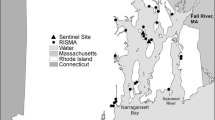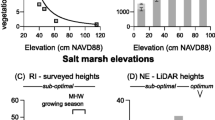Abstract
Ecotones, zones of abrupt biological transition typically reflecting strong physical gradients, may be particularly sensitive to changes in environmental conditions. Our characterization of the ecotone between salt marshes and uplands in the Elkhorn Slough watershed in central California revealed that extent of appropriate habitat for native high marsh species endemic to this zone is extremely limited. The ecotone is highly invaded, with non-native upland weeds accounting for a significant proportion of cover. We investigated responses to two anthropogenic landscape management strategies, restriction of tidal exchange through water control structures and cattle grazing. Moderate tidal restriction resulting in muted tidal exchange dramatically decreased ecotone width, native marsh plant richness, and cover by native ecotone specialists. Even stronger tidal restriction resulting in very low tidal exchange led to a seaward shift of the ecotone into the area formerly occupied by mid-marsh vegetation; upland plants now occupy the former ecotone zone so net loss of wetland habitat has occurred. Cattle grazing led to a very substantial increase in bare ground, a significant decrease in native marsh plant richness and a significant increase in non-native plant cover. Thus, both of these management regimes can have significant negative impacts on rare salt marsh ecotone extent and biodiversity.



Similar content being viewed by others
References
Adam P (2002) Salt marshes in a time of change. Environmental Conservation 29:39–61
Adam P, Wilson NC, Huntley B (1988) The phytosociology of coastal saltmarsh vegetation in New South Wales. Wetlands (Australia) 7:35–85
Alexander HD, Dunton KH (2002) Freshwater inundation effects on emergent vegetation of a hypersaline salt marsh. Estuaries 25:1426–1435
Andresen H, Bakker JP, Brongers M, Heydemann B, Irmler U (1990) Long-term changes of salt-marsh communities by cattle grazing. Vegetatio 89:137–148
Bos D, Bakker JP, de Vries Y, van Lieshout S (2002) Long-term vegetation changes in experimentally grazed and ungrazed back-barrier marshes in the Wadden Sea. Applied Vegetation Science 5:45–54
Burdick DM, Dionne M, Boumans RM, Short FT (1997) Ecological responses to tidal restorations of two northern New England salt marshes. Wetlands Ecology and Management 4:129–144
Caffrey J, Brown M, Tyler WB, Silberstein M (2002) Changes in a California estuary: a profile of Elkhorn Slough. Elkhorn Slough Foundation, Moss Landing
Callaway JC (2001) Hydrology and substrate. In: Zedler JB (ed) Handbook for restoring tidal wetlands. CRC, Boca Raton, pp 89–113
Campos JA, Herrera M, Biurrun I, Loidi J (2004) The role of alien plants in the natural coastal vegetation in central-northern Spain. Biodiversity and Conservation 13:2275–2293
Clarke KR, Warwick RM (2001) Change in marine communities: an approach to statistical analysis and interpretation, 2nd edn. PRIMER-E, Plymouth
Clarke KR, Gorley RN (2006) PRIMER (Plymouth Routines In Multivariate Ecological Research) v. 6. In. PRIMER-E Ltd., Plymouth
Costa JC, Neto C, Arsenio P, Capelo J (2009) Geographic variation among Iberian communities of the exotic halophyte Cotula coronopifolia. Botanica Helvetica 119:53–61
de Leeuw J, Apon LP, Herman PMJ, de Munck W, Beeftink WG (1994) The response of salt marsh vegetation to tidal reduction caused by the Oosterschelde storm-surge barrier. Hydrobiologia 282(283):335–353
French JR (2008) Hydrodynamic modelling of estuarine flood defence realignment as an adaptive management response to sea-level rise. Journal of Coastal Research 24:1–12
Grewell BJ, Callaway JC, Ferren WR Jr (2007) Estuarine wetlands. In: Barbour MG, Keeler-Wolf T, Schoenherr AA (eds) Terrestrial Vegetation of California, 3rd edn. University of California Press, CA, pp 124–154
Hayes GF, Holl KD (2003) Cattle grazing impacts on annual forbs and vegetation composition of mesic grasslands in California. Conservation Biology 17:1694–1702
Hickman JC (ed) (1993) The Jepson Manual: higher plants of California. University of California Press, Berkeley
Huntsinger L, Bartolome JW, D’Antonio CM (2007) Grazing management on California’s Mediterranean grasslands. Chapter 20. In: Stromberg MR, Corbin JD, D’Antonio CM (eds) California grasslands: Ecology and management. University of California Press, Berkeley, pp 233–253
Ibarra-Obando SE, Poumian-Tapia M, Morzaria-Luna HN (2010) Long-Term effects of tidal exclusion on salt marsh plain species at Estero de Punta Banda, Baja California. Estuaries and Coasts 33:753–768
James ML, Zedler J (2000) Dynamics of wetland and upland subshrubs at the salt marsh-coastal sage scrub ecotone. American Midland Naturalist 143:298–311
Jensen A (1985) The effect of cattle and sheep grazing on salt-marsh vegetation at Skallingen, Denmark. Vegetatio 60:37–48
Kennish ML (2002) Environmental threats and environmental future of estuaries. Environmental Conservation 29:78–107
Kiehl K, Eischeid I, Gettner S, Walter J (1996) Impact of different sheep grazing intensities on salt marsh vegetation in northern Germany. Journal of Vegetation Science 7:99–106
Levin LA et al (2001) The function of marine critical transition zones and the importance of sediment biodiversity. Ecosystems 4:430–451
Levin PS, Ellis J, Petrik R, Hay ME (2002) Indirect effects of feral horses on estuarine communities. Conservation Biology 16:1364–1371
Lloyd KM, McQueen AAM, Lee BJ, Wilson RCB, Walker S, Bastow WJ (2000) Evidence on ecotone concepts from switch, environmental and anthropogenic ecotones. Journal of Vegetation Science 11:903–910
Macdonald KB (1977) Coastal salt marsh. In: Barbour MG, Major J (eds) Terrestrial vegetation in California. John Wiley & Sons, New York, pp 263–294
Martone R, Wasson K (2008) Impacts and interactions of multiple human perturbations in a California salt marsh. Oecologia 158:151–163
Matthews MA (1998) An illustrated field key to the flowering plants of Monterey County and ferns, fern allies, and conifers. California Native Plant Society, Sacramento
Minchinton TE, Bertness MD (2003) Disturbance-mediated competition and the spread of Phragmites australis in a coastal marsh. Ecological Applications 13:1400–1416
Page HM (1995) Variation in the natural abundance of 15N in the halophyte Salicornia virginica, associated with groundwater subsidies of nitrogen in a southern California salt-marsh. Oecologica 104:181–188
Peters DPC et al (2006) Integrating patch and boundary dynamics to understand and predict biotic transitions at multiple scales. Landscape Ecology 21:19–33
Risser PG (1995) The status of the science examining ecotones—a dynamic aspect of landscape is the area of steep gradients between more homogeneous vegetation associations. Bioscience 45:318–325
Ritter AF, Wasson K, Lonhart SI, Preisler RK, Woolfolk A, Griffith KA, Connors S, Heiman K (2008) Ecological signatures of anthropogenically altered tidal exchange in estuarine ecosystems. Estuaries and Coasts 31:554–571
Roman CT, Niering WA, Warren RS (1984) Salt-marsh vegetation change in response to tidal restriction. Environmental Management 8:141–149
SanLeon DG, Isco J, Sanchez JM (1999) Spartina patens as a weed in Galician saltmarshes (NW Iberian Peninsula). Hydrobiologia 415:213–222
Sanzone S, McElroy A (eds) (1998) Ecological impacts and evaluation criteria for the use of structures in marsh management. U.S. Environmental Protection Agency, Washington DC, USA. EPA-SAB-EPEC-98-003
Schröder HK, Kiehl K, Stock M (2002) Directional and non-directional vegetation changes in a temperate salt marsh in relation to biotic and abiotic factors. Applied Vegetation Science 5:33–44
Sun S, Cai Y, Tian Y (2003) Salt marsh vegetation change after a short-term tidal restriction in the Changjiang estuary. Wetlands 23:257–266
Traut BH (2005a) The role of coastal ecotones: a case study of the salt marsh/upland transition zone in California. Journal of Ecology 93:279–290
Traut BH (2005b) Effects of nitrogen addition and salt grass (Distichlis spicata) upon high salt marsh vegetation in northern California, USA. Estuaries 28:286–295
Walker S et al (2003) Properties of ecotones: evidence from five ecotones objectively determined from a coastal vegetation gradient. Journal of Vegetation Science 14:579–590
Watson EB, Byrne R (2009) Abundance and diversity of tidal marsh plants along the salinity gradient of San Francisco Estuary: implications for global change ecology. Plant Ecology 205:113–128
Woolfolk AM (1999) Effects of human trampling and cattle grazing on salt marsh assemblages in Elkhorn Slough, California. M.S. Thesis. Moss Landing Marine Laboratories and California State University Sacramento
Zedler JB (2000) Progress in wetland restoration ecology. Trends in Ecology & Evolution 15:402–407
Zedler JB, Kercher S (2004) Causes and consequences of invasive plants in wetlands: opportunities, opportunists, and outcomes. Critical Reviews in Plant Sciences 23:431–452
Zedler JB, Callaway JC, Sullivan G (2001) Declining biodiversity: why species matter and how their functions might be restored in Californian tidal marshes. Bioscience 51:1005–1017
Acknowledgments
We are indebted to K. Griffith for assistance in the field, and to E. Van Dyke for the elevation data. R. Clarke, G. Gilbert, P. Raimondi and P. Somerfield generously provided advice on the statistical analyses. We are grateful to A. D’Amore and R. Preisler for their long-term assistance with ecotone investigations. B. Lyon, S. Pennings, and two anonymous reviewers provided thoughtful comments that improved the manuscript. The Elkhorn Slough Foundation supported this research by providing access to various wetlands. This research was funded by a grant from the National Oceanic and Atmospheric Administration’s Estuarine Reserve Division, made to the Elkhorn Slough Foundation on behalf of the California Department of Fish and Game which manages the Elkhorn Slough National Estuarine Research Reserve.
Author information
Authors and Affiliations
Corresponding author
Appendix
Appendix
Table 3
Rights and permissions
About this article
Cite this article
Wasson, K., Woolfolk, A. Salt Marsh-Upland Ecotones in Central California: Vulnerability to Invasions and Anthropogenic Stressors. Wetlands 31, 389–402 (2011). https://doi.org/10.1007/s13157-011-0153-z
Received:
Accepted:
Published:
Issue Date:
DOI: https://doi.org/10.1007/s13157-011-0153-z




